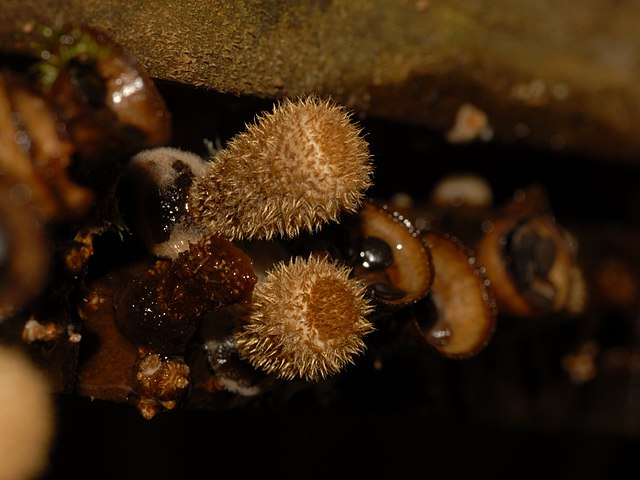Cyathus stercoreus, commonly known as the dung-loving bird's nest or the dung bird's nest, is a species of fungus in the genus Cyathus, family Nidulariaceae. Like other species in the Nidulariaceae, the fruiting bodies of C. stercoreus resemble tiny bird's nests filled with eggs. The fruiting bodies are referred to as splash cups, because they are developed to use the force of falling drops of water to dislodge and disperse their spores. The species has a worldwide distribution, and prefers growing on dung, or soil containing dung; the specific epithet is derived from the Latin word stercorarius, meaning "of dung".
Cyathus stercoreus
Two young specimens of C. stercoreus with intact epiphragms.
The basidia of C. stercoreus during various stages of development. (1) young basidia of usual form; (2) a double basidium; (3–6) basidia with 4 to 8 developing spores; (7–9) basidia collapsing, with spores still attached; (10) a collapsing basidium with two spores still attached, and one separated.
Cyathus is a genus of fungi in the Nidulariaceae, which is a family collectively known as the bird's nest fungi. They are given this name as they resemble tiny bird's nests filled with "eggs" – structures large enough to have been mistaken in the past for seeds. However, these are now known to be reproductive structures containing spores. The "eggs", or peridioles, are firmly attached to the inner surface of this fruit body by an elastic cord of mycelia known as a funiculus. The 45 species are widely distributed throughout the world and some are found in most countries, although a few exist in only one or two locales. Cyathus stercoreus is considered endangered in a number of European countries. Some species of Cyathus are also known as splash cups, which refers to the fact that falling raindrops can knock the peridioles out of the open-cup fruit body. The internal and external surfaces of this cup may be ridged longitudinally ; this is one example of a taxonomic characteristic that has traditionally served to distinguish between species.

Cyathus
The shaggy (tomentose) outer peridial surface of C. striatus
Cyathus striatus (a) young and mature fruit bodies in longitudinal section; (b), (c) single peridiole entire, and in section
Cyathus stercoreus






